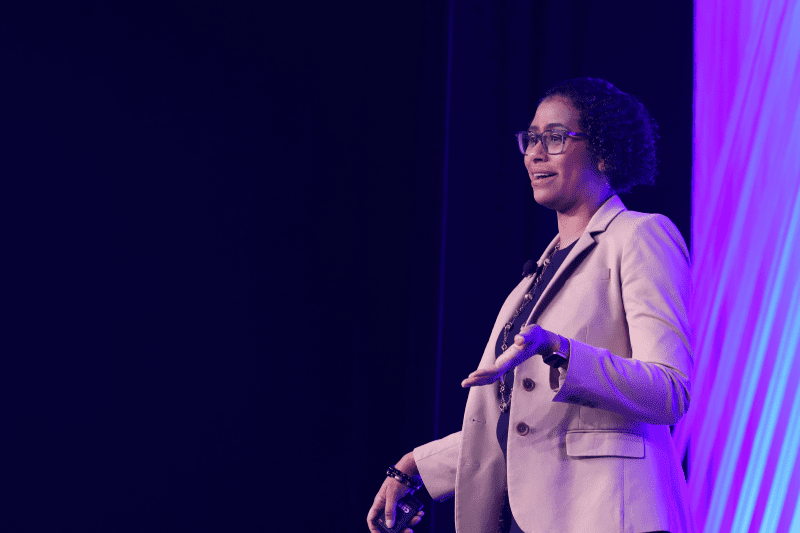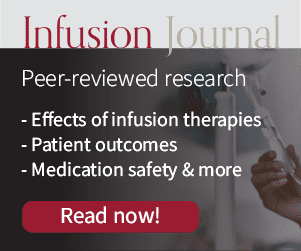Tuesday at NHIA 2023 — Health equity in home infusion
Eliminating the inequities in how people access and receive health care can go a long way toward improving health care delivery, outcomes, and population health, according to Christina Ritchey from Optum Infusion Pharmacy. Equity in health care means the state in which everyone has a fair and just opportunity to attain their highest level of health.
Inequities could cost our health care system $1 trillion by 2040, according to Ritchey. “That’s a tremendous impact on our health care system, but also patients.” Achieving this requires efforts to address historical and contemporary injustices, overcoming economic, social, and other obstacles to health and health care, and eliminating preventable health disparities.
Disparities in the way people access and use health care can be based on numerous factors, including race, ethnicity, language, income, disability, sexual orientation, gender identity, age, and geography. “For example, 39% of people in the U.S have limited English proficiency. We need to think about whether we are communicating in the patient’s preferred language, and do we have the resources to meet their needs,” Ritchey says. Patient education materials, prescription labels, instructions for line care and pump operation, and more need to understandable to ensure patient safety and compliance with therapy.
Social structures—even from the past—create disparities that affect health, on a structural level, institutional level, and individual level, according to keynote speaker Erika McMullen from Moxie Consulting Group. A good example is redlining, the practice of withholding services from potential customers in neighborhoods with low classifications. “There is a direct line from the 1930s to today’s health disparities in those communities,” observes McMullen. “COVID just shined a light on that.”
“Improved health equity can happen when we acknowledge the impact of social structure on health and well being and have the courage to transform them,” adds McMullen.
With 60% (or even as much as 80% in some studies) of health driven by social, behavioral, and environmental factors, it’s important for providers to consider social determinants of health when planning and providing care. Social determinants of health include:
- Health care access and quality
- Neighborhood and built environment
- Social and community context
- Education access and
- Economic stability
Powerful Inequities Brought to Light
Alex Mills from the University of Mississippi School of Pharmacy/Medical Center shared some powerful statistics about inequities related to the LGBTQI+ community and really opened eyes to the critical need to create affirming environments for patients as well as employees in health care.
Transgender females have 3x the unemployment rate of their cisgender counterparts and 50% reported discriminatory hiring or firing practices. Workplace discrimination leads to disengagement and turnover. Small steps such as sharing pronouns can signify you are an ally and indicate a culture of inclusivity, creating opportunity for others to share theirs.
This might seem trivial, but language is crucially important. When transgender and gender-diverse (TGD) individuals were surveyed about their experience with health care, they reported an overall more positive experience with providers who used inclusive language and were more engaged in their care. They also saw an improvement in mood disorder and a 50% decrease in suicidality.
This metric makes a huge impact in this community as the biggest health disparity for LGBTQ individuals is in mental health. 40% of TGD have attempted suicide. Many LGBTQ individuals begin to overcome depression when they embrace their sexual orientation or gender identify (SOGI)—supporting this with a gender affirming environment is literally lifesaving.
Increasingly, providers are being called on to recognize and address equity issues in their provision of services. To be effective, Ritchey says they should advance their data and analytics, build a diverse workforce and a culture that reflects their community, recognize their own unconscious biases, and support public policy initiatives designed to bring equity to health care delivery.
According to Mills, one-third of TGD reported a negative experience with a health care provider and up to 50% of TGD youth avoid mental health services because of fear the provider doesn’t have the LGBTQ competency needed to provide care.
He provided guidance on how to normalize conversations on SOGI while also keeping questions to what is medically necessary. He highlighted standards published by The Joint Commission for data collection related to LGBTQ-inclusivity, encouraged providers to be cognizant of using chosen names (rather than given) and pronouns even in charts as patients can have access in real-time, and suggested resources for continuing education and implicit bias testing.
For front-facing staff, including pharmacists, “being affirming and culturally competent is critical,” according to Mills, and it is the #1 factor for LGBTQ patients.
Shifting from Competency to Responsiveness
McMullen says we need to go beyond competency and provide culturally responsive care. According to McMullen, 32% of TGD or nonbinary individuals reported that a provider refused to see them. The key to culturally responsive care is asking, “How can I respond in this moment in a way that seeks to understand, demonstrates genuine interest and compassion, and values the patient’s culture?”
Mills outlines simple steps to focus on when creating an affirming environment and building culturally responsive skills. First, we have to remove all assumptions and ask. Ask the patient what their preferences are. Until we can get feedback from a patient, we should use person-first language rather than identify first. Engage with them as a person rather than any labels of what they might be or what they have.
“The communication you have with patients is key,” adds McMullen. “It can help them make shifts for better outcomes.” Providers shouldn’t view culture as a problem, but as a frame for understanding, she says.
McMullen shared key concepts for providers delivering culturally responsive care. “Be more curious about your patient and their values and priorities. Be aware of and mitigate your biases (both implicit and explicit). Acknowledge how historical and current bias, discrimination, and racism, impacts patients and their health. And acknowledge that the health care system doesn’t always work equally or equitably for everyone.”
Each approach is a piece of the puzzle, McMullen adds. Use them to build trust, learn, and adapt.
Mills concluded his session by reminding us that this isn’t something we can achieve competency in and check the box. It is an evolving process. As allies, we are responsible for continuing to learn, continuing to put emphasis on the essential nature of our commitment to strive for equity, inclusion and accessibility.


